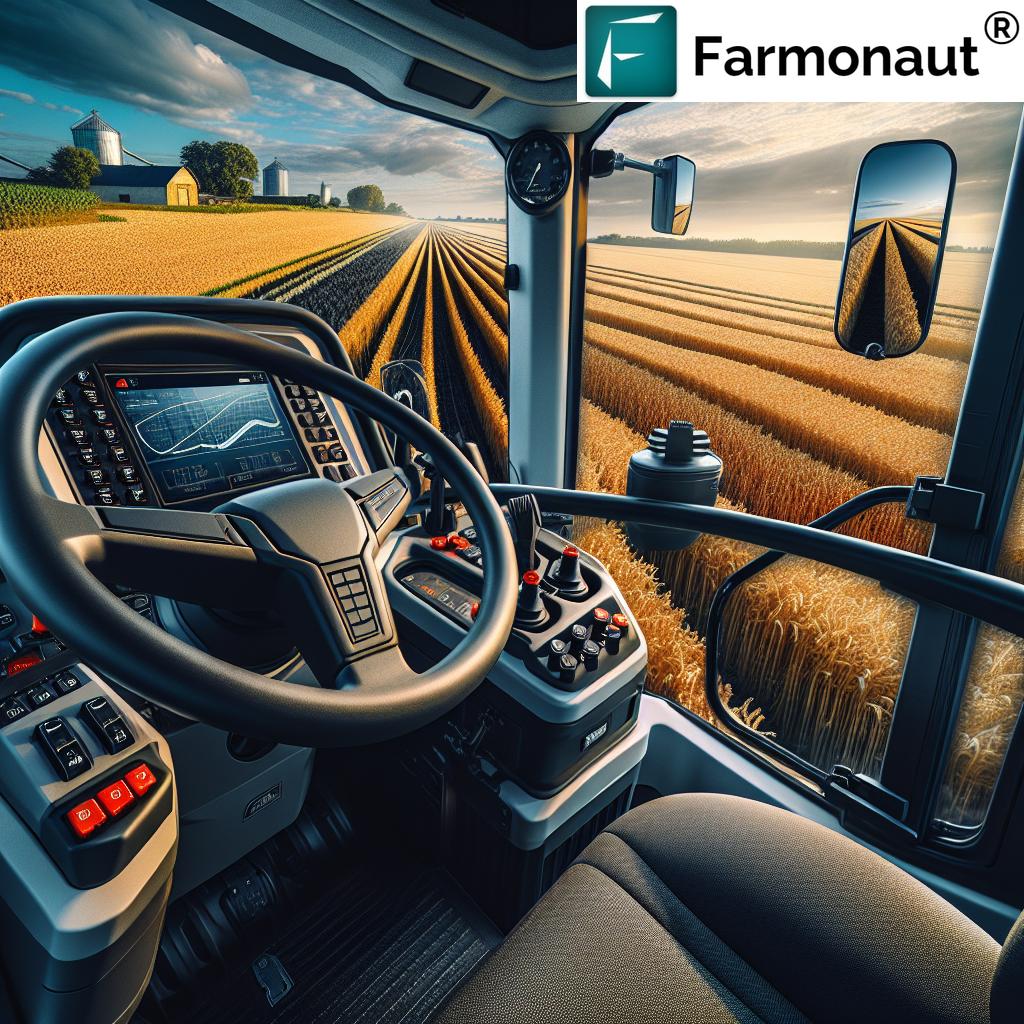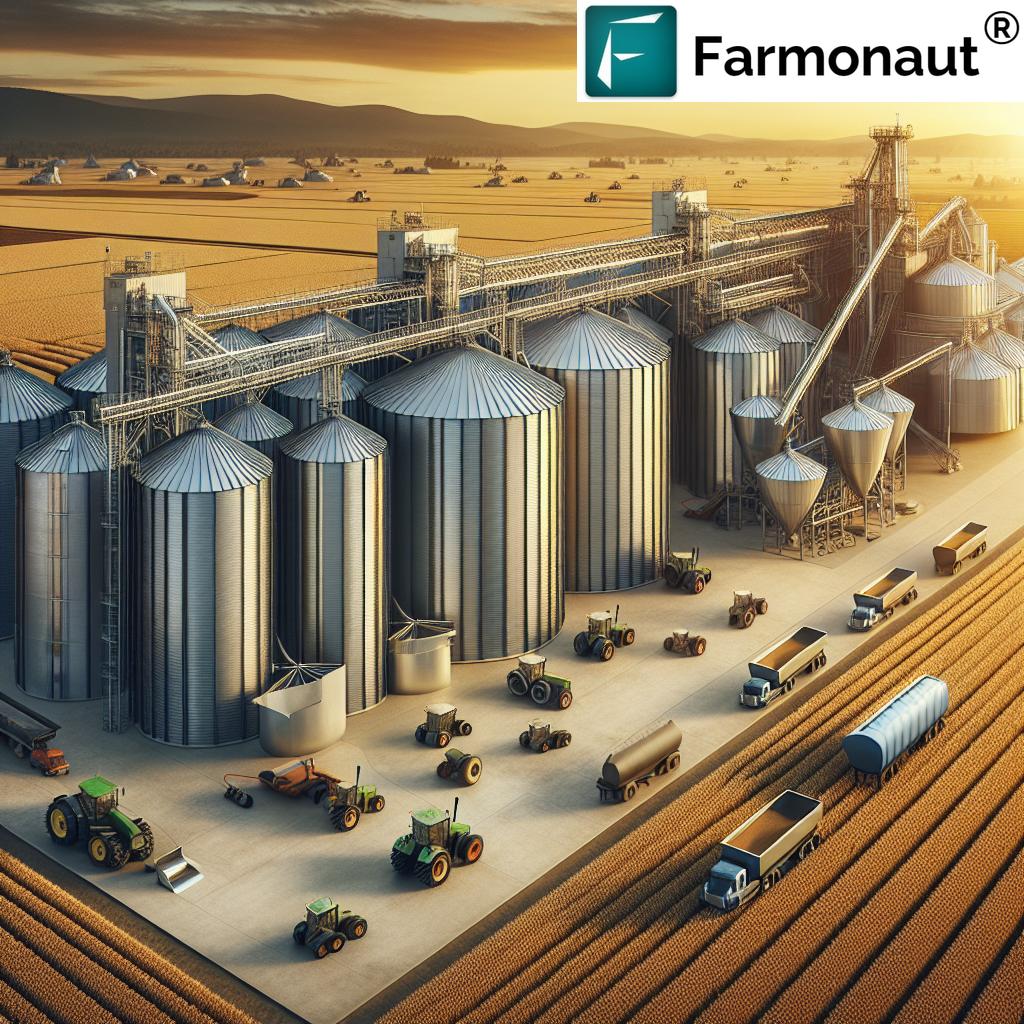Discover the Best Utility Vehicles for Agriculture: Comparing Top Models, Features, and Accessories

“Modern agricultural utility vehicles offer up to 3 seating configurations, enhancing versatility for various farm tasks.”
Welcome to our comprehensive guide on utility vehicles for agriculture! We at Farmonaut understand the crucial role that efficient equipment plays in modern farming. In this blog post, we’ll explore the latest trends in agricultural utility vehicles, compare top models, and highlight essential features and accessories that can transform your farming operations.
As technology continues to advance, so do the capabilities of utility vehicles designed for agricultural use. From mid-size workhorses to full-size diesel powerhouses, we’ll delve into the specifications and benefits of various models to help you make an informed decision for your farm. Let’s get started!
The Evolution of Agricultural Utility Vehicles
Utility vehicles have come a long way since their inception in the farming industry. Today’s models are more versatile, powerful, and technologically advanced than ever before. Here’s a quick overview of the main types of utility vehicles currently available for agricultural use:
- Mid-size Utility Vehicles: Perfect for smaller farms or specific tasks
- Full-size Diesel Utility Vehicles: Ideal for heavy-duty work and larger operations
- Electric Utility Vehicles: Eco-friendly options gaining popularity in agriculture
Each of these categories offers unique advantages, and the best choice for your farm will depend on your specific needs, terrain, and scale of operations.
Key Features to Consider in Agricultural Utility Vehicles
When searching for the perfect utility vehicle for your farm, there are several key features to keep in mind:
- Transmission Type: Many modern models feature advanced CVT (Continuously Variable Transmission) systems for smooth operation
- Cargo Capacity: Look for vehicles with ample cargo space and hydraulic dump capabilities
- Seating Configuration: Versatile seating options allow for easy transition between solo work and team tasks
- Fuel Type: Choose between gas, diesel, or electric options based on your farm’s needs and environmental considerations
- Customization Options: Many manufacturers offer accessory packages to tailor the vehicle to your specific requirements
Let’s dive deeper into each of these features to understand how they can benefit your agricultural operations.
Advanced Transmission Systems
One of the most significant advancements in utility vehicles for agriculture is the widespread adoption of CVT systems. These transmissions offer several advantages over traditional geared transmissions:
- Smoother acceleration and deceleration
- Improved fuel efficiency
- Better performance on varying terrains
- Reduced maintenance requirements
When comparing utility vehicles, pay close attention to the transmission type, as it can significantly impact your vehicle’s performance and longevity.
Cargo Capacity and Hydraulic Dump Features
For many farmers, the ability to haul heavy loads efficiently is a top priority. Modern utility vehicles often come equipped with impressive cargo capacities and hydraulic dump features. These capabilities can streamline various tasks on the farm, such as:
- Transporting feed, fertilizer, or harvested crops
- Moving construction materials for farm improvements
- Clearing debris or snow from fields and paths
When evaluating utility vehicles, consider both the maximum cargo weight and volume to ensure it meets your farm’s needs.
Versatile Seating Configurations
Flexibility is key in agricultural operations, and many utility vehicles now offer multiple seating configurations to accommodate various tasks and team sizes. Some popular options include:
- Single-row seating for solo work
- Bench seating for two or three passengers
- Convertible cargo areas that can be transformed into additional seating
Consider how you typically use your utility vehicle and choose a model that offers the seating flexibility you need.
“Agricultural utility vehicles now come in 3 main types: mid-size, full-size diesel, and electric models.”
Fuel Options: Gas, Diesel, and Electric
The choice between gas, diesel, and electric utility vehicles can have a significant impact on your farm’s operations and environmental footprint. Here’s a brief overview of each option:
- Gas: Typically more affordable upfront, with good power and readily available fuel
- Diesel: Offers excellent torque and fuel efficiency, ideal for heavy-duty tasks
- Electric: Environmentally friendly, quiet operation, and lower maintenance costs
Consider factors such as fuel availability, environmental regulations, and the typical duration of your vehicle’s use when making your decision.
Customization and Accessory Packages
Many manufacturers offer a wide range of accessories and customization options to tailor utility vehicles to specific agricultural needs. Some popular accessories include:
- Specialized tires for different terrains
- Cab enclosures for weather protection
- Winches and tow hitches
- Sprayer attachments for pest control or fertilization
- GPS and telematics systems for precision agriculture
When shopping for a utility vehicle, inquire about available accessory packages and how they can enhance your farm’s productivity.
Comparing Top Utility Vehicle Models for Agriculture
To help you make an informed decision, we’ve compiled a comparison table of some of the top utility vehicle models currently available for agricultural use. This table provides a quick overview of key specifications and features:
| Vehicle Model | Size Category | Fuel Type | Transmission Type | Cargo Capacity (lbs) | Towing Capacity (lbs) | Seating Configuration | Key Features | Customization Options | Estimated Price Range |
|---|---|---|---|---|---|---|---|---|---|
| Model A | Mid-size | Gas | CVT | 1000 | 1500 | 2-3 | 4WD, Hydraulic dump | Cab, Winch | $10,000 – $15,000 |
| Model B | Full-size | Diesel | CVT | 1500 | 2000 | 3-6 | 4WD, Power steering | Sprayer, GPS | $15,000 – $20,000 |
| Model C | Mid-size | Electric | Direct drive | 800 | 1200 | 2 | Silent operation, Zero emissions | Solar panel, Extended battery | $12,000 – $18,000 |
| Model D | Full-size | Gas | CVT | 1200 | 1800 | 4-5 | 4WD, All-terrain tires | Roof rack, Bed extender | $14,000 – $19,000 |
| Model E | Full-size | Diesel | CVT | 2000 | 2500 | 6 | 4WD, Heavy-duty suspension | Snow plow, Heated cab | $18,000 – $25,000 |
This table provides a quick comparison of various utility vehicle models, helping you narrow down your options based on your specific needs and budget.
Choosing the Right Utility Vehicle for Your Farm
Selecting the ideal utility vehicle for your agricultural operations requires careful consideration of several factors:
- Farm Size and Terrain: Larger farms with varied terrain may benefit from full-size, 4WD models
- Primary Tasks: Consider the vehicle’s cargo capacity, towing ability, and available attachments
- Budget: Factor in both the initial purchase price and long-term operational costs
- Environmental Considerations: Electric models may be preferable for farms prioritizing sustainability
- Maintenance and Support: Research the availability of genuine parts and nearby dealers for service
By carefully evaluating these factors, you can choose a utility vehicle that will serve as a valuable asset to your farm for years to come.
Maximizing Efficiency with Utility Vehicle Accessories
To get the most out of your agricultural utility vehicle, consider investing in accessories that can enhance its functionality. Some popular options include:
- Sprayer Attachments: For efficient application of pesticides or fertilizers
- Snow Plows: Essential for farms in colder climates
- Cargo Bed Liners: Protect your vehicle from wear and tear
- Winches: Useful for pulling out stuck equipment or moving heavy objects
- GPS Systems: Improve navigation and enable precision farming techniques
Many manufacturers offer package deals on accessories, which can be a cost-effective way to customize your utility vehicle.
Maintenance Tips for Agricultural Utility Vehicles
Proper maintenance is crucial for ensuring the longevity and reliability of your utility vehicle. Here are some essential tips:
- Follow the manufacturer’s recommended maintenance schedule
- Regularly check and change fluids (oil, coolant, transmission fluid)
- Inspect and rotate tires to ensure even wear
- Keep the vehicle clean, especially after use in muddy or dusty conditions
- Store the vehicle in a covered area when not in use
- Address any unusual noises or performance issues promptly
By following these maintenance tips, you can extend the life of your utility vehicle and minimize downtime on your farm.
The Future of Agricultural Utility Vehicles
As technology continues to advance, we can expect to see further innovations in agricultural utility vehicles. Some trends to watch for include:
- Increased adoption of electric and hybrid models
- Integration of autonomous driving features
- Enhanced connectivity and data collection capabilities
- Improved ergonomics and operator comfort
- Development of more specialized attachments and accessories
Staying informed about these trends can help you make forward-thinking decisions when investing in utility vehicles for your farm.
Conclusion: Transforming Your Agricultural Operations with the Right Utility Vehicle
Choosing the best utility vehicle for your agricultural needs can significantly impact your farm’s efficiency and productivity. By carefully considering factors such as size, fuel type, features, and accessories, you can select a vehicle that will serve as a valuable asset for years to come.
Remember to factor in long-term considerations such as maintenance, dealer support, and the availability of genuine parts when making your decision. With the right utility vehicle, you’ll be well-equipped to tackle a wide range of tasks and keep your farm running smoothly.
We hope this guide has provided valuable insights into the world of agricultural utility vehicles. As you continue your search for the perfect vehicle, don’t hesitate to consult with local dealers and fellow farmers to gather additional perspectives and experiences.
FAQs
- Q: What’s the main difference between mid-size and full-size utility vehicles?
A: Mid-size utility vehicles are generally more compact and maneuverable, making them ideal for smaller farms or specific tasks. Full-size utility vehicles offer greater cargo and towing capacity, making them better suited for larger operations and heavy-duty work. - Q: Are electric utility vehicles practical for farm use?
A: Electric utility vehicles are becoming increasingly practical for farm use, offering quiet operation, lower maintenance costs, and zero emissions. They’re particularly suitable for farms with shorter operating distances and access to charging infrastructure. - Q: How important is the CVT transmission in agricultural utility vehicles?
A: CVT transmissions are highly beneficial in agricultural settings, offering smooth operation, improved fuel efficiency, and better performance across various terrains. They’re especially useful when frequent speed changes are required. - Q: What should I consider when choosing accessories for my utility vehicle?
A: Consider your farm’s specific needs, such as the types of tasks you’ll be performing, the terrain you’ll be traversing, and any seasonal requirements. Prioritize accessories that will enhance your productivity and efficiency. - Q: How often should I service my agricultural utility vehicle?
A: Service intervals can vary depending on the make and model of your vehicle, as well as usage patterns. Generally, it’s recommended to follow the manufacturer’s maintenance schedule, which often includes more frequent service intervals for vehicles used in demanding agricultural environments.

While we’ve covered a lot of ground in this guide, the world of agricultural utility vehicles is vast and ever-evolving. To stay updated on the latest trends and technologies in farming, consider exploring precision agriculture solutions like those offered by Farmonaut. Our satellite-based crop monitoring and AI-driven advisory systems can complement your utility vehicle investments, helping you maximize efficiency and productivity on your farm.
Explore Farmonaut’s Agricultural Technology Solutions:
For developers interested in integrating agricultural data into their own systems, check out our API and API Developer Docs.
Farmonaut Subscriptions
By combining the right utility vehicle with advanced agricultural technology solutions, you can take your farming operations to the next level. Whether you’re managing a small family farm or overseeing a large agricultural enterprise, the key to success lies in choosing the right tools and staying informed about the latest innovations in the industry.
Remember, the best utility vehicle for your farm is one that not only meets your current needs but also has the flexibility to adapt to future challenges and opportunities in agriculture. Keep exploring, keep innovating, and keep growing!
As you continue to enhance your agricultural operations with the right utility vehicles and technology, don’t forget to leverage the power of data-driven insights. Farmonaut’s satellite-based crop monitoring and AI advisory systems can provide valuable information to complement your on-the-ground operations, helping you make more informed decisions about resource allocation, crop management, and overall farm productivity.
By integrating advanced utility vehicles with cutting-edge agricultural technology, you’re positioning your farm for success in an increasingly competitive and technology-driven industry. Whether you’re looking to optimize your current operations or explore new avenues for growth, the combination of reliable equipment and data-driven insights can help you achieve your goals.
As we conclude this comprehensive guide on agricultural utility vehicles, we encourage you to continue exploring the latest advancements in farming technology. Stay curious, stay informed, and most importantly, stay committed to finding the best solutions for your unique agricultural needs. With the right tools and knowledge at your disposal, there’s no limit to what you can achieve in modern agriculture!












